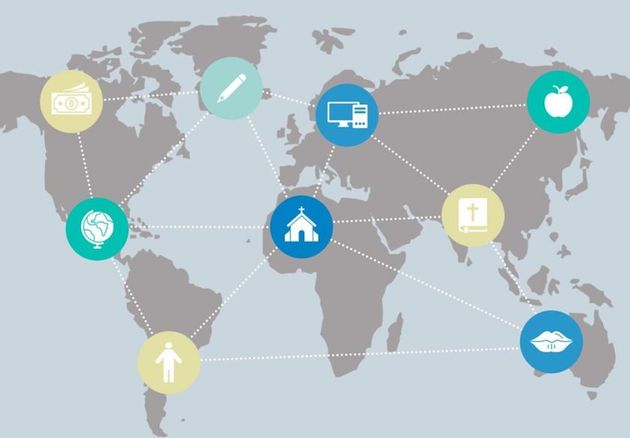Efforts to integrate different modes, means, and aspects could lead to a contextualized innovation of ministries.
![Photo via [link]Lausanne Movement[/link].](https://cms.evangelicalfocus.com/upload/imagenes/654e084708eee_lauinn.jpg) Photo via [link]Lausanne Movement[/link].
Photo via [link]Lausanne Movement[/link].
Innovation takes place in different ways in different contexts. In many cases, it is an accumulative process rather than a paradigmatic or episodic change that presupposes discontinuity.
Innovation studies in other sectors such as industry inform Christian leaders significantly, but different goals and realities for ministries need to be considered.
Missionaries who are working in developing countries need to be wise in adopting innovation strategies and models originating from developed countries. What does it mean to be realistic in pursuing innovation in an intercultural context of Christian ministry?

Missionaries need to pursue innovation in their ministries, but their approaches and processes should be contextualized to their given environments.
Their ministerial environments are different not only from those of the business sector, but also from those of their home churches and the realities of Christian organizations in their home countries.
Just as in the task of contextualization, innovation in Christian ministries as a whole must maintain a solid commitment to the eternal Word of God while trying to legitimate new and creative ways, expressed through new cultural and technological tools in this ever-changing world.[1]
Innovation in this perspective means what Scott Cormode calls ‘meaning-making innovation’.[2]
The issue of innovation is not separate from the issue of contextualization, because both pursue relevance. In many cases, while contextualization pursues cultural relevance, innovation pursues more technological relevance.In that sense, innovation can be considered as part of contextualization. The real challenge is how to exercise leadership to contextualize the efforts for ministry innovation.
Cultural phenomena in the global age are characterized by hybridization. The hybridization of cultural characteristics has been around for a long time, but it becomes more explicit and permeating at different levels of cultural dynamics in this global age.
There is no such thing as a pure culture rooted only in traditional culture. In the words of Ian N. Pieterse, who posits in effect that hybridity has become ordinary and regular in popular culture, ‘globalization in cultural terms tends toward a global mélange’.[3]
This characteristic of intercultural mingling reflects a postmodern sensibility, forming a deeply creative process that crosses existing categories in many cultural domains, including even social structures.[4]
Hybridity in many cases means ‘in-between’ in human life.[5] Most cultural communities are between tradition and change, between global and local, and between different perspectives.
When it comes to the technology sector, the Fourth Industrial Revolution (hereafter 4IR) is characterized by the convergence of digital technology, artificial intelligence, robotics, computer science, 3D printing, and other advanced technologies based on the existing foundation of information communications technology (ICT) that has already been achieved by the
Third Industrial Revolution.[6] 4IR is increasingly relevant in many parts of the world and in many sectors of society. It is increasingly relevant even in the context of missionary service in a foreign country.[7]
The phenomena of cultural mélanges show a pragmatic turn in worldview change. Sometimes paradigms that are seemingly incompatible with each other mix together to result in a synthesized form.
Even in social science research, traditionally separate research approaches are combined in mixed methods research. Pragmatism is not committed to any one system of philosophical understanding of reality as an absolute unity presupposing that truth is what works at the time.[8]
Whereas mixing could lead to syncretism in religious matters, in technology and culture it can be pragmatic wisdom when applied discretely.
In many discussions, the notion of integration does not neglect the need to pursue consonance or commensurability among synthesized paradigms.
Technological integration is practical wisdom in many ministry situations. In the context of missionary service on the mission field, advanced technologies are not fully available, for which there has been an emphasis on the appropriate technology.
A good sense of balance practically could mean integrating conventional technologies and available technologies of 4IR to optimize the use of technology and the approach to innovation.
Historically there have always been tensions between continuity and change, but it is a matter of both-and, not of either-or. Ted Esler’s point of ‘riding the wave of existing innovation’ is pragmatic advice based on his view that incremental innovation is most promising for most leaders.[9]
Having a balance by pursuing incremental innovation is a realistic posture that overcomes temptations of trying to be too clever.[10]
Integration efforts could be applied in different areas of missionary service. In running congregational gatherings, missionaries could integrate in-person gatherings with virtual gatherings, sometimes involving hybrid modes.
One pastor asked me if his church should stop offering virtual worship services, leaving behind a period of restriction due to the COVID-19 pandemic, to encourage in-person participation.
Maybe an integrated hybrid mode is the wise and realistic approach. In financing missionary services, it is increasingly difficult to stick to the policies of faith missions due to the aggravating financial situations of the supporting churches.
Depending solely on missional business to finance missional programs and activities is not realistic either, because such business models are not fully developed yet.
Integrating faith missions approaches and missional business approaches can be a realistic solution in many contexts.
In processing contextualization in missionary service, there is also the need to integrate aspects of accommodation and transformation.
Traditionally, models of contextual theologies tended to lean toward accommodation, sometimes resulting in weakening the emphasis on biblical essentials.
Careful effort should follow to transform the worldview(s) of the host culture based on a proper worldview exegesis carried out in the earlier phase of accommodation. It is a matter of both-and and also of balance.Such efforts to integrate different modes, means, and aspects could lead to a contextualized innovation of ministries, especially in the context of missionary service in a developing country.
Innovative integration is practical wisdom in this complex world of cultures, technologies, and perspectives.

Innovative integration of means and tools takes several postures for innovators. First, it takes dwelling on your own situation. Applying theories derived from foreign models may not be realistic.
According to Michael Fullan, the primary basis of action is to dwell on your own context of realities before adopting other practitioners’ suggestions.[11]
A contextualized approach of innovation takes the given realities into consideration naturally.
Second, it takes listening to new and diverse voices. As Schein and Schein note, the quality of conversation is the key variable in changing organizational cultures and practices, in the sense that decisions based on various sources of information raise the overall relevance of leadership for innovation.[12]
Gleaning insight from various sources is a key leadership skill to bring about changes and transformation.
Third, it takes deep and continuous learning. Ted Esler submits that it is a myth to believe that innovation is for the genius inventor. He emphasizes the importance of ordinary practitioners to be curious learners despite the fact that many managers discourage curiosity.[13]
Fourth, it takes collaboration both internally and externally. Innovations are neither developed by solo geniuses nor developed in closed networks, but through connected working relationships, often deriving from ‘the adjacent possible’, not from distant or exotic sources.[15]
Diversity is necessary in the sense that innovation is the result of synthesizing ideas of different domains simultaneously in many cases, which practically demands the collaboration of diverse people.[16]
In understanding innovation, we need a holistic and integrative approach. Innovation is not just a technical but a social term involving all domains of social activities.[17]
Understanding the process of innovation as a cumulative synthesis provides a micro foundation highlighting the ‘ongoingness’ of its process in practical terms.[18]
One of the most important implications of this holistic yet detailed understanding of innovation is the need for collaboration with diverse people across disciplines, sectors, generations, and backgrounds.
Let us learn new ideas from one another as we cross boundaries in our ministry contexts.[19]
Steve Sang-Cheol Moon is a Korean missiologist serving as founder and CEO of the Charis Institute for Intercultural Studies (www.ciis.kr). His main ministry focus is to facilitate mission research globally.
He occasionally teaches missiology at several Christian universities and seminaries around the world. He is a member of the LGA Editorial Advisory Board.
This article originally appeared in the September 2023 issue of the Lausanne Global Analysis and is published here with permission. To receive this free bimonthly publication from the Lausanne Movement, subscribe online at www.lausanne.org/analysis.
1. Scott Cormode, The Innovative Church: How Leaders and Their Congregations Can Adapt in an Ever-Changing World (Michigan: Baker Academic, 2020), 3, 34, Kindle.
2. Cormode, The Innovative Church, 32.
3. Jan Nederveen Pieterse, Globalization and Culture: Global Mélange (Lanham: Rowman & Littlefield, 2019), x.
4. Pieterse, Globalization and Culture, 57, 59, 76, 81.
5. Ibid, 94.
6. Definition of the Fourth Industrial Revolution by Klaus Schwab ‘The Fourth Industrial Revolution: What It Means, How to Respond,’ World Economic Forum 2016 Annual Meeting, www.weforum.org/agenda/2016/01/ the-fourth-industrial-revolution-what-it-means-and-how-to-respond.
7. Please refer to my previous article, ‘Missions from Korea 2017: The Fourth Industrial Revolution and Missions,’ International Bulletin of Mission Research Vol. 41(2) (February 2017): 124
8. John W. Creswell and J. David Creswell, Research Design: Qualitative, Quantitative, and Mixed Methods Approaches (Fifth Edition) (Los Angeles: SAGE, 2018), 10-11.
9. Ted Esler, The Innovation Crisis: Creating Disruptive Influence in the Ministry You Lead (Chicago: Moody Publishers, 2021), 114, 245.
10.Peter F. Drucker emphasizes that innovation has to be handled by ordinary human beings, adding that anything too clever in design or execution is almost bound to fail. Peter F. Drucker, Innovation and Entrepreneurship (New York: Harper, 1985), 136.
11. Michael Fullan, Change Leader: Learning to Do What Matters Most (San Francisco: Jossey-Bass, 2011), 21.
12. Edgar H. Schein & Peter A. Schein, The Corporate Culture Survival Guide (Third Edition) (Hoboken, NJ: John Wiley & Sons, 2019), 91.
13. Esler, The Innovation Crisis, 108, 235.
14. Ibid, 248.
15.Fullan, Change Leader, 98-100.
16. Cormode, The Innovative Church, 156; Esler, The Innovation Crisis, 187, 259.
17. Drucker, Innovation and Entrepreneurship, 33.
18.Raghu Garud and M. Turunen, ‘Microfoundations of Innovation as Process: Usher’s Cumulative Synthesis Model,’ in The Oxford Handbook of Organizational Change & Innovation (Second Edition), eds M. S. Poole and A. H. Van de Ven (Oxford: Oxford University Press, 2020), 583, 599, 600.
19.Editor’s Note: See article entitled ‘Innovation and Startup Mentality in Mission’ by Paul Dzubinski in Lausanne Global Analysis, September 2017,

Las opiniones vertidas por nuestros colaboradores se realizan a nivel personal, pudiendo coincidir o no con la postura de la dirección de Protestante Digital.
Si quieres comentar o